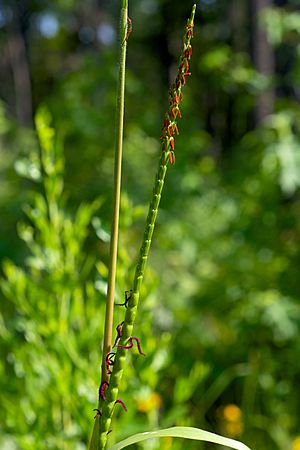Eastern gamagrass facts for kids
Quick facts for kids Eastern gamagrass |
|
|---|---|
 |
|
| Close-up of male and female flowers | |
| Scientific classification | |
| Genus: |
Tripsacum
|
| Species: |
dactyloides
|
Eastern gamagrass, also known as Tripsacum dactyloides or Fakahatchee grass, is a type of grass that grows well in warm weather. It forms thick clumps and spreads out like a carpet. You can find this grass all over the Western Hemisphere, from the eastern United States down to northern South America. It loves sunny, moist places like riverbanks and wet grasslands. It can even grow in areas where the land has been changed by people.
Eastern gamagrass is often grown on farms to feed animals.
Contents
About Eastern Gamagrass
How it Looks
Eastern gamagrass usually grows about 2 to 3 feet (0.6 to 0.9 meters) tall. But it can sometimes reach an amazing height of 8 to 10 feet (2.4 to 3 meters)! This plant belongs to the Poaceae family, which is the grass family. It is a distant relative of corn.
Roots
Eastern gamagrass has several short, thick roots called rhizomes. These strong roots help the plant stay upright. They also help it survive long periods of dry weather or floods. The roots grow deep into the ground and branch out from the lower parts of the stem.
Leaves
The leaves of eastern gamagrass grow close together from the base of the plant. Each clump of grass can grow up to 4 feet (1.2 meters) wide. The stems and leaves often have a purplish color and are smooth. The smooth leaves can be about 1.5 meters (5 feet) long and 9 to 35 millimeters (0.35 to 1.4 inches) wide. They have small hairs near their base. The leaves have a clear middle vein and can be 12 to 24 inches (30 to 60 cm) long.
Flowers
Eastern gamagrass flowers bloom from late March to early October. Its flowers grow on spikes. Each plant has both male and female flowers, but they are separate. This type of plant is called monoecious. The flower clusters can be 10 to 30 centimeters (4 to 12 inches) long. They usually look like a single spike or a group of two or three spikes.
Fruits and Seeds
The seeds of eastern gamagrass grow from June to September. The seeds do not all ripen at the same time, and they grow slowly. When the seeds are ready, the seedhead breaks apart. Each part that breaks off holds one seed. The seedhead can be 6 to 10 inches (15 to 25 cm) long. The female seed parts separate easily when they are ripe, like pop-beads.
Where it Grows
You can find Tripsacum dactyloides across a wide area in the United States. It grows from Connecticut in the east to Nebraska in the west, and south to Florida and Texas. It also grows much further south, in countries like Paraguay and Brazil in South America. People have also planted this grass in other places, even outside its natural home.
How to Grow It
Eastern gamagrass grows best in wet areas, like floodplains along rivers. It also thrives in moist, nonalkaline (not too salty) lowlands. These places can stay flooded for a long time, which the grass can handle. The best soil for eastern gamagrass is moist, fertile, and drains a little. It needs about 900 to 1500 millimeters (35 to 60 inches) of rain each year. The soil should have a pH between 5.5 and 7.5.
This grass can survive being flooded for up to three weeks without dying. Its deep roots, which can go about 4.5 meters (15 feet) underground, help it survive dry periods too.
Uses of Eastern Gamagrass
Eastern gamagrass was once a very important food source for animals. Early settlers in the United States used it as high-quality feed. However, it became less common as people started growing more grain crops and raising cattle.
In the late 1980s and early 1990s, people started to notice eastern gamagrass again. It is a great plant for feeding animals in the summer. It grows a lot, tastes good to animals, and is easy for them to digest. Because of these reasons, it is perfect for hay and pasture. Farmers can control when animals graze on it. This grass starts growing earlier than other warm-season grasses. It also grows later than cool-season grasses.
It is important not to let animals eat too much of the grass. The plant needs to store energy in its leaf bases to grow back. If it is grazed too much before it can store this energy, the plant might die.
Eastern gamagrass is also a good home for wildlife. The way its leaves grow creates hollow spaces and a tent-like cover. This makes it a nice place for animals to live. For example, wild birds like quails and prairie chickens can build their nests in the empty spaces. The grass also provides good cover for grassland sparrows during the winter.
Gamagrass grows from mid-April to mid-September. This is a bit earlier than other native warm-season grasses like big bluestem (Andropogon gerardi) and switchgrass (Panicum virgatum). Because it grows so well in summer, it is a great food source when other cool-season grasses are not growing as much.
Genetics
Scientists have been able to create new types of plants by combining Zea mays (corn) with eastern gamagrass.

